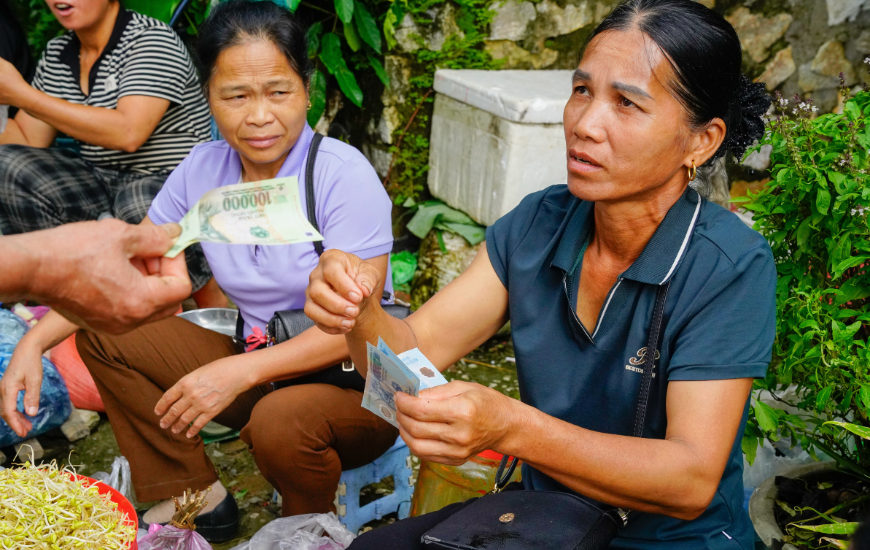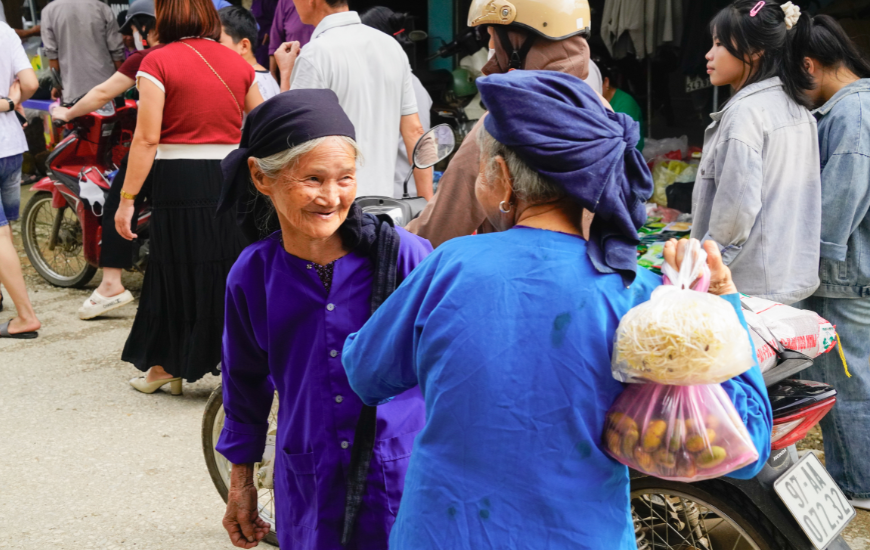 Chợ Lèng is a periodic rural market in Ba Be - Mr Linh's Adventures
Chợ Lèng is a periodic rural market in Ba Be - Mr Linh's AdventuresWhat is a "chợ phiên"?
The
Chợ Lèng market is a "
chợ phiên"," which can be translated as "periodic rural market" or "rotating market": chợ means "market" and phiên refers to the session, the period. But the expression covers much more than just a place for commercial exchange. The
chợ phiên is a centuries-old tradition: residents of isolated villages meet at regular intervals to sell and buy products, trade, exchange news, and maintain their social ties. Unlike daily city markets, it embodies a living spectacle of the ingenuity and resilience of communities facing the difficult geography of the Northern mountains.
And
Chợ Lèng also goes beyond simple commercial transactions. It brings together the
Tày,
Mông, and
Dao ethnic groups, where colorful traditional costumes and warm exchanges are as prominent as the stalls. As a gateway to
Ba Bể National Park, the
Chợ Lèng market also plays an essential logistical role for travelers wishing to explore the lake and surrounding jungle, and discover a simple, intimate life, far from urban anonymity.
 Chợ phiên is much more than bargaining - Mr Linh's Adventures
Chợ phiên is much more than bargaining - Mr Linh's AdventuresThrough the markets of Ba Bể
The Ba Bể region is a true network of interconnected markets, each with its own schedule. With Chợ Rã as the central market, Chợ Lèng, Pù Mắt, Khang Ninh, and Cao Thượng form a dynamic commercial ecosystem. To visit them, you must rely on the lunar calendar. For Chợ Lèng, it is held on the 5th and 10th days of the lunar month, from 6 am to 11 am. This ingenious organization, with staggered calendars, allows buyers and sellers to travel from one market to another throughout the month. This ensures a supply of products and a regular income for local communities.
 Chợ phiên brings together local communities - Mr Linh's Adventures
Chợ phiên brings together local communities - Mr Linh's AdventuresChợ Lèng, a cultural and culinary immersion
The social dimension of the chợ phiên is first seen in the attire: residents wear their most beautiful traditional clothes, richly embroidered and in vibrant colors, transforming the market into an open-air theater. The Tày, Mông, and Dao ethnic groups meet there with warmth and pride, displaying their identity through the bartering of traditional objects, the sharing of embroidered patterns, and the sale of festive clothing. Folk songs and dances often emerge between the stalls, like a living thread weaving traditions among the participants.
It is also an opportunity to discover the culinary and agricultural richness of the region. Among the immediate pleasures you will find traditional cakes like banana cake, mugwort cake, sticky rice cakes, sweet soup and grass jelly. The market is renowned for its forest vegetables like Mac Khi (in the Tay language), a plant resembling a tamarind leaf but without acidity, which is very fragrant and nutritious. Bamboo shoots and fern fronds are also common. The market also offers a variety of local meats, including black pork, beef, horse meat, as well as poultry and small animals.
 Local products just waiting to be eaten - Mr Linh's Adventures
Local products just waiting to be eaten - Mr Linh's AdventuresChợ Lèng, between tradition and tourist initiatives
While the chợ phiên continue to meet the daily needs of locals, new initiatives have emerged to attract visitors. The Pác Ngòi night market, launched in August 2023, is an example of this duality. Located in the heart of the village, it is held every Friday and Saturday evening and is primarily aimed at tourists. There you can find food stalls, crafts, and permanent cultural shows. This coexistence raises an essential question: does tourism alter culture, or, on the contrary, does it help it to survive and spread? The question remains open…
Chợ Lèng, some practical recommendations
Getting there
From Hanoi: The most practical and flexible option is a private car or minivan: 4-5 hours (approximately 240-260 km) via QL3 and then provincial roads. Or by shared bus/minivan, with regular departures from Hanoi (stations like My Đình or private agencies), a journey of about 5 hours.
From Bắc Kạn City: Take a local bus or a motorbike taxi.
To fully enjoy it
First, it is recommended to plan your visit according to the lunar calendar.
Next, arrive early in the morning, which will allow you to capture the market's hustle and bustle from the moment the locals arrive.
Don't forget to bring enough cash, as ATMs are rare in mountainous areas and it will be necessary for your purchases, food, and local transport.
And finally, to facilitate your immersion, a local guide can help you interpret the lunar calendar and immerse yourself in the authenticity of these markets' life.
 Chợ phiên continue to meet the daily needs of locals - Mr Linh's Adventures
Chợ phiên continue to meet the daily needs of locals - Mr Linh's AdventuresChợ Lèng, a timeless value
The
Ba Bể markets go far beyond their commercial roles: they embody the history, culture, and economy of local communities while reinventing themselves in the face of the challenges and opportunities of tourism. Organized according to the ancestral rhythm of the lunar calendar,
Chợ Lèng and its neighboring chợ phiên offer rare access to a living tradition that supports the social cohesion of the region's people. For the traveler, exploring these markets is a deep immersion into the heart of daily life in the Northeast Vietnamese mountains, an experience that transcends simple commerce to become a moment of connection with the culture and way of life of the residents.
Courtesy of Ba Be National Park